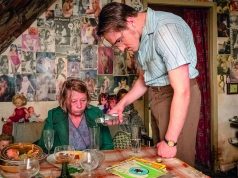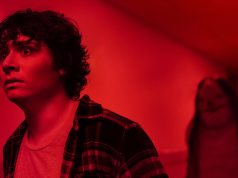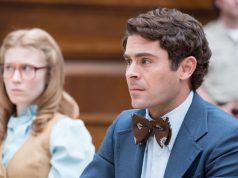(Reviewed in 2001, with revisions in 2017.)
For better or worse, “Halloween” began the modern teen slasher genre. It came before “Friday the 13th” (which was clearly inspired by it) and was far superior to it, establishing tension and avoiding cheap scares. Where subsequent slasher flicks would focus on the blood and murdering, “Halloween” had very little blood and only five murders — one of which occurred offscreen.
The film’s prologue is among the creepiest I’ve seen. It is Halloween 1963. A girl goes upstairs to fool around with her boyfriend, unaware they’re being watched by someone. Through the watcher’s point of view, we see the boyfriend leave; then we head upstairs, find the girl naked in her bedroom … and we stab her. Then we go downstairs and outside the house, where the point of view finally shifts and we realize the murderer is a little boy. Creeee-py.
The rest of the film takes place 15 years later. The boy, Michael Myers, has been in a psychiatric facility and has not spoken a word since the murder. His doctor, the lugubrious Sam Loomis, played by the inappropriately named Donald Pleasence, is on his way there to make sure he’s not released on parole. Apparently, despite the boy not having spoken a word in 15 years, much less committed any additional crimes, Dr. Unpleasence is convinced he is incapable of being rehabilitated. Dr. Doom-and-Gloom is not what you’d call a bleeding-heart liberal, to put it mildly.
Anyway, while at the facility, a clumsy nurse lets Michael steal her car and head back to his hometown of Haddonfield, Ill. (Michael does this so easily, one suspects the nurse did it on purpose.) How can a man who has been in a mental institution since the age of 6 drive a car? Good question. When someone in the movie asks it, Dr. Morbid says, “Maybe someone around here gave him lessons!” He says it very accusingly, like it’s a foregone conclusion. I say if you’re going to bring up the plot holes in your movie, you should fix them, too, not just make them worse with stammering explanations.
“Halloween” (1978) B
“Halloween II” (1981) C+
“Halloween III: Season of the Witch” (1982) F
“Halloween 4: The Return of Michael Myers” (1988) D
“Halloween 5” (1989) C-
“Halloween: The Curse of Michael Myers” (1995) C
“Halloween H20: 20 Years Later” (1998) D+
“Halloween: Resurrection” (2002) C-
“Halloween” (2007) D-
“Halloween II” (2009)
Back in Haddonfield, the old Myers home is considered haunted by local kids, and probably a few episodes of “Scooby-Doo” centered around it. Dour teen Laurie Strode (Jamie Lee Curtis) doesn’t pay it no never mind, though, and is not afraid to live in the neighborhood. In fact, this very night — Halloween, no less — she is set to babysit a little boy who lives just around the corner from it, all by herself in the dark with scary movies on TV.
Laurie is an interesting character, insofar as she is the protagonist despite being utterly devoid of personality. She has two friends, Annie and Lynda, who hate each other and her.
Sure enough, Michael shows up in town, and Dr. Creepy gets the local sheriff to help him keep an eye out. It’s the rare instance in horror films where the cops actually believe the town’s in danger, but they don’t do anything about it — issue APB’s or put the word out on the radio — for fear of creating a panic. Once again, the movie paints itself into a corner and then just tramps all over the fresh paint to get out.
There are surprisingly few murders, considering how many you find in subsequent films of this genre (and of this series, for that matter). Carpenter also wins points for some spine-tingly camera set-ups and extended shots, the calmness of which almost makes you forget you’re watching a horror film.
He doesn’t win any points for that damn musical score, though. He wrote it himself, and it has two themes. The most famous one is that four-note piano riff, which is perfect for the mood of the film. The other one, though, is all cheesy synthesizers and goofy crap, and it drives me crazy. Awful, awful stuff.
I am amazed at how little time it takes people to have sex in Haddenfield, Ill. The opening sequence has Michael’s sister and her boyfriend doin’ it, in real time, and it takes no more than one minute. Later, another amorous couple gets it on, once again with no cutting away, and once again it is over in mere seconds. The girl remarks that it was “fantastic,” too, which makes me wonder just how much sex she’s had.
Donald Pleasence’s performance is calculated and chilling, and I like it. Jamie Lee Curtis doesn’t do much but scream (though not as much as she’s famous for — only three real screams in this film), and it’s hard to get behind a main character who’s so unexciting. But maybe it’s Michael Myers who is the real main character. In which case, mission accomplished: I’m freaked out.
B (1 hr., 31 min.; )





